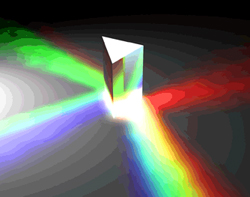A “foot-candle” is a standard unit, established as reference that is used when measuring quantity of light.
As lighting professionals we need to know “how much” light we’re working with. Like an inch on a ruler, a reference unit to measure physical objects, the foot-candle is a reference unit for a non-physical element, light.
One (1) foot-candle equals the total intensity of light that falls upon a one (1) square foot surface that is placed one foot away from a point source of light that equals one (1) candle power.
Note: The term candela also refers to candle power—1 candela = 1 candle power.
A light meter is used to measure the foot-candle level of a scene. The meter incorporates a photosensitive cell that creates an electrical current when light falls upon it. The current increases as the level of light falling on it is increased.
The meter will display the foot-candle level in either a digital form or as a needle moving along an incremental scale. The meter uses the electrical current level as a reference to the level of foot-candles that is falling onto the photosensitive cell. The higher the current, the higher the foot-candle reading will be.
The metric reference for light level is known as lux. One lux equals the total intensity of light that falls on a one square meter surface that is placed one (1) meter away from a point source of light that equals one (1) candle power.
Spectrum, The Natural Magic Of Light
The visible spectrum is a small portion of the electromagnetic spectrum. The entire spectrum includes electromagnetic waves such as gamma rays, x-rays, ultraviolet, infrared, microwaves, radio and television waves. Light waves vary in length and are measured in nanometers (nm) equal to one billionth of a meter. The wavelength determines the color of visible light produced.
hort wavelengths are located in the violet portion of the spectrum, following the shorter ultraviolet waves. As the waves lengthen, they produce the remainder of the visible spectrum. The longest visible waves reside in the red portion of the spectrum prior to the invisible infrared waves.
Light sources use varying amounts of the visible spectrum to produce “white light”, as the following diagram illustrates. A tungsten incandescent studio lamp has very little of the violet waves, while large portions of the yellow to red wavelengths are used. An incandescent source produces high levels of infrared waves. They create more heat than light.
Arc sources, such as fluorescents and HMI, use specific portions of the spectrum. The spectral distribution of an arc shows the spikes of waves that are incorporated in this type of light source.
Arcs sources, HMI & Xenon, have ultraviolet waves within their spectrum. Protection from these UV waves is necessary when using these sources. Manufacturers include a trip switch in lighting units that use these types of arc sources. Opening the lens, which blocks the UV, will trip the switch and shut off power to the bulb.
Filters, The Human Magic Of Light
Colored filters are used in lighting to alter the output of a light source. A “white light” source is comprised of a range of colors within the visible spectrum combining to create the white light.
The use of color filtration dates back to early theatres where colored “gel” (dyed gelatin) was used to color the lights. The term “gel” is still in use, although today’s most commonly used colored filters are plastic, polyester or polycarbonate. Polycarbonate filters tend to last longer than polyester based filters. Glass filters are also used to color light.
How it works: A color filter blocks unwanted color from the original light source and allows the desired color to pass through it. For example, the spectral colors that create “white light” are stopped by a green “gel” so that only the specific green range of the spectrum is allowed to pass. Note that a filter cannot add portions of the spectrum that do not inherently exist within the specific light source itself.
Filters use two different methods of blocking the unwanted portions of the spectrum. The first method is known as absorption, where plastic-based filters absorb the unwanted portions of the spectrum. This means infra red (heat produced from a tungsten bulb) will be absorbed and cause the plastic to fade and deteriorate.
Colors that block a large portion of the infrared will deteriorate quicker than a filter that allows it to pass. A deep blue filter will deteriorate quicker than a light red filter when used in a tungsten light source.
The second method is known as interference. Dichroic filters, also known as dichroic mirrors, reflect the unwanted portions of the spectrum instead of absorbing them. This type of filter only interferes with the original light and then allows the desired color to pass through it.
Dichroic filters last longer because they do not absorb the infrared and use glass as their base. They can be shattered, like glass, so care must be taken in the handling of this type of filter.
Dichroic reflectors are used in some of today’s lights to allow infra red to pass out the back of the reflector while the remaining light waves are reflected into the front of the lighting instrument.
Dale Lee has been a professional in three countries in all aspects of entertainment, from the splendor of touring ice shows to small independent stage productions on miniscule budgets.















